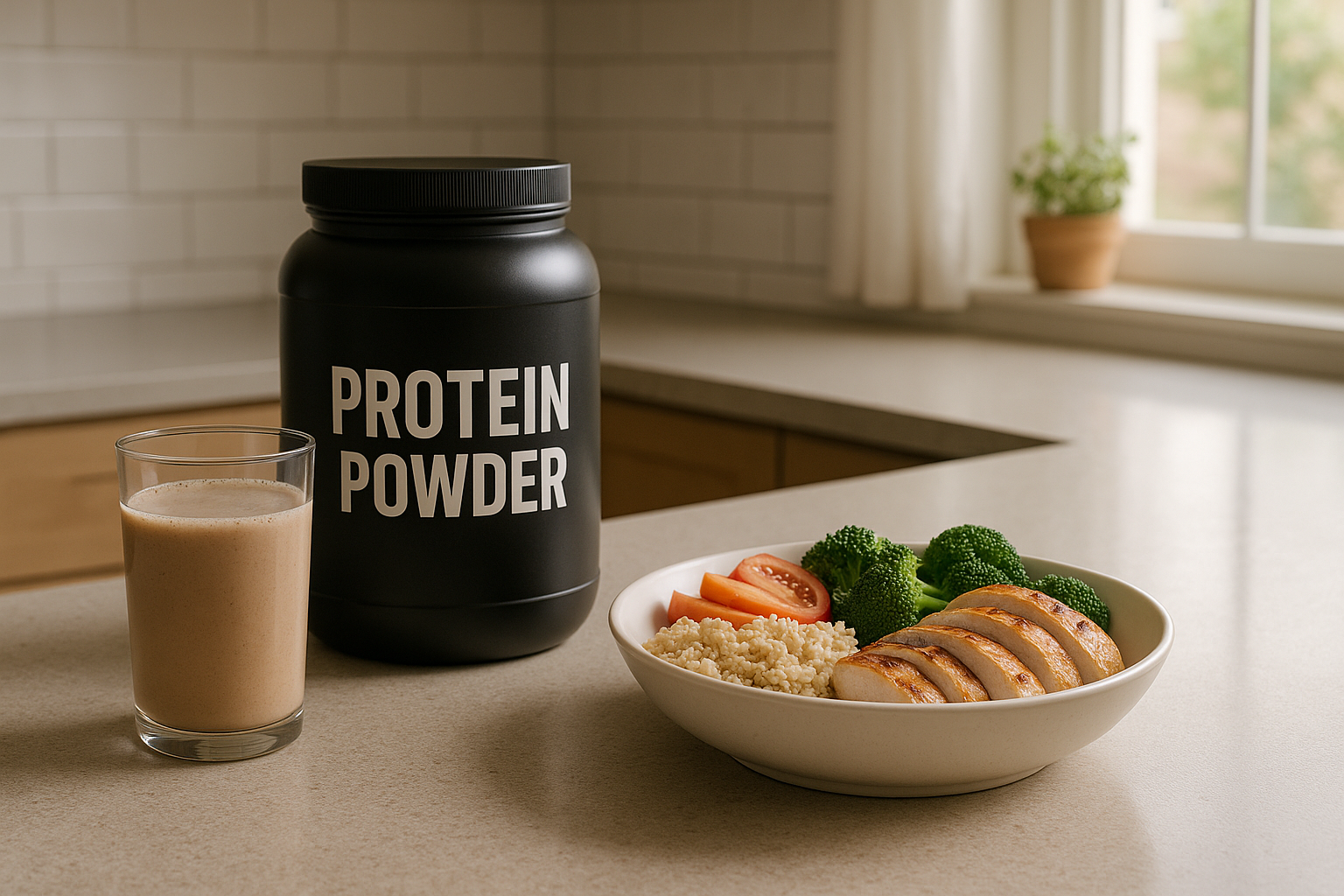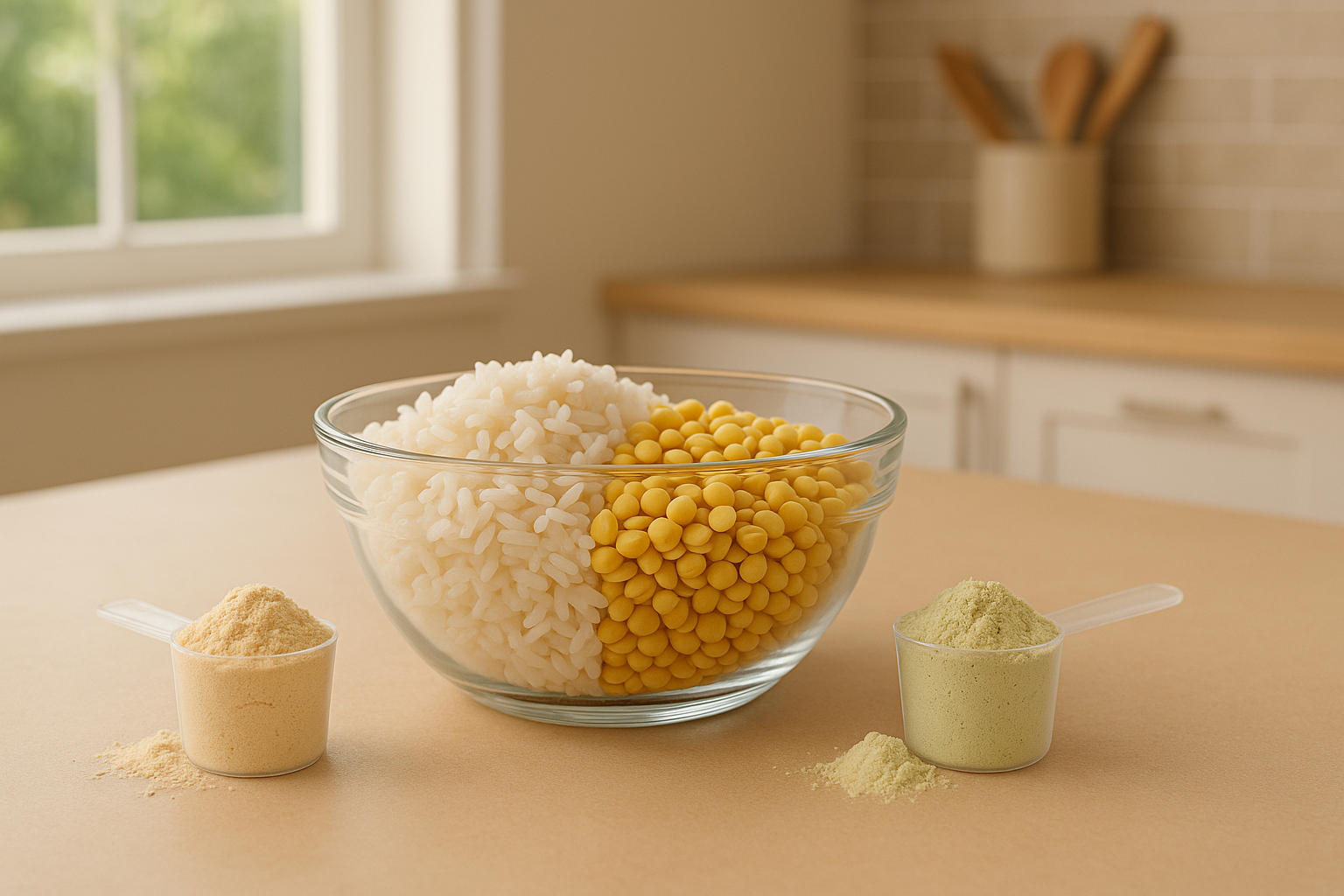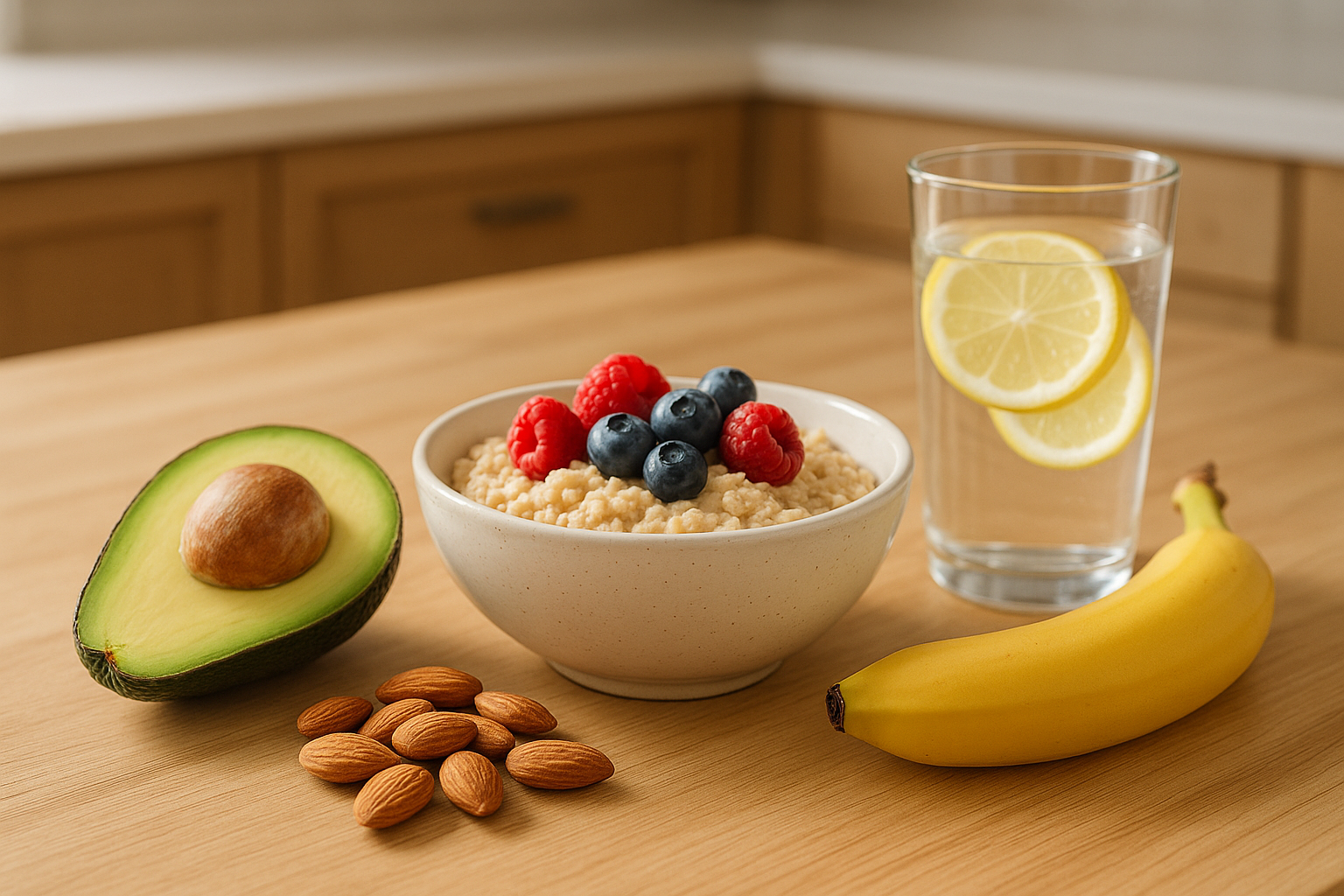
Top 7 Adaptogenic Herbs for Mitochondrial Health
If you're feeling tired, foggy, or just not performing at your best, your mitochondria - your cells' energy powerhouses - might need support. Certain herbs, known as adaptogens, can help improve mitochondrial function, boost energy production, and protect your cells from stress. Here's a quick look at the top 7 adaptogenic herbs for mitochondrial health:
- Rhodiola Rosea: Boosts energy and fights fatigue.
- Ashwagandha: Enhances stress resilience and endurance.
- Cordyceps Militaris: Increases ATP (cellular energy) production.
- Panax Ginseng: Improves vitality and stamina.
- Bacopa Monnieri: Supports brain health and cognitive function.
- Schisandra Chinensis: Promotes overall wellness and endurance.
- Eleutherococcus Senticosus: Strengthens physical adaptability and energy metabolism.
Each of these herbs is backed by research showing their ability to support mitochondrial health, improve energy, and enhance physical and mental performance. Below, you'll find a detailed breakdown of how they work, their benefits, and key studies.
Quick Comparison
| Herb | Key Benefits | Active Compounds | Suggested Dose |
|---|---|---|---|
| Rhodiola Rosea | Fights fatigue, boosts stamina | Salidroside, Rosavin | 200–576 mg daily |
| Ashwagandha | Reduces stress, improves energy | Withanolides, Withaferin A | 500–1,500 mg daily |
| Cordyceps Militaris | Enhances ATP production | Cordycepin, Polysaccharides | 3–4 g daily |
| Panax Ginseng | Increases vitality and endurance | Ginsenosides | 100–200 mg daily |
| Bacopa Monnieri | Improves memory and cognition | Bacosides | 300–500 mg daily |
| Schisandra Chinensis | Boosts endurance, reduces stress | Schisandrins, Lignans | Follow product guidelines |
| Eleutherococcus Senticosus | Enhances adaptability, energy | Eleutherosides, Syringin | 400 mg daily |
Keep reading to learn how each herb supports mitochondrial health and how to incorporate them into your routine.
1. Rhodiola Rosea
How it affects mitochondria
Rhodiola Rosea supports mitochondrial energy production by enhancing ATP synthesis. Its key bioactive compound, salidroside, activates AMP-activated protein kinase (AMPK), which plays a role in maintaining energy balance. Additionally, its antioxidant properties shield mitochondria from oxidative stress and encourage the formation of new mitochondria. Together, these effects contribute to better stamina and physical performance.
Energy and stamina effects
This herb has been shown to boost athletic performance and energy levels. A 2021 study by Williams et al. found that resistance-trained men experienced about an 8% greater improvement in mean concentric velocity during bench press exercises after taking Rhodiola Rosea supplements [2].
In 2013, Noreen et al. reported that recreationally active women performed better in a 6-mile bicycle time trial after taking an acute dose of 3 mg/kg (approximately 170 mg) of Rhodiola Rosea one hour before exercise. Their time improved from 25.8 minutes (placebo) to 25.4 minutes (P = 0.04) [2].
Active compounds
Rhodiola Rosea owes its benefits to its bioactive compounds, particularly salidroside and rosavin. High-quality supplements are standardized to include at least 3% rosavin and 0.8–1% salidroside, typically in a 3:1 ratio. Other compounds like flavonoids, catechins, and phenylpropanoids also contribute to its adaptogenic properties.
Research findings
A 2022 review highlighted Rhodiola Rosea's ability to reduce exercise-induced muscle damage, improve muscle health, and enhance explosive power [1]. For best results, studies recommend taking around 200 mg (with ~1% salidroside and ~3% rosavin) about an hour before exercise. Higher doses, ranging from 1,500 to 2,400 mg daily, have been linked to improved sprint performance and resistance training outcomes [2].
"Rhodiola's potential effect on healthy stress responses, energy production, and mitochondrial function may promote athletic performance, as seen in clinical studies involving both professional athletes and non-athletic individuals" [1].
2. Ashwagandha
How It Impacts Mitochondria
Ashwagandha plays a notable role in supporting mitochondrial function by boosting energy use in brown and beige fat cells as well as skeletal muscle. One of its key components, Withaferin A, helps transform pre-adipocytes into energy-efficient beige fat cells and increases oxygen utilization in muscle cells [5]. Additionally, its antioxidant properties help repair oxidative damage, reduce lipid peroxidation, and neutralize harmful reactive oxygen species, all of which protect mitochondrial health [4]. These benefits often translate into better exercise performance.
Effects on Energy and Stamina
Ashwagandha helps maintain energy and stamina by reducing levels of blood urea nitrogen, lactic acid, and corticosterone. This supports sustained energy levels and improved endurance during physical activity [3].
"It was reported that supplementation with ashwagandha may enhance the adaptations and gains produced by exercise, making it a helpful addition to a resistance training regimen." – Shiyi Guo and Mohammad J. Rezaei [4]
Research Insights
Clinical trials have highlighted the performance-enhancing potential of ashwagandha. For instance, in an 8-week study involving elite Indian cyclists, participants who took 500 mg of aqueous ashwagandha root extract twice daily saw a 13% improvement in VO₂ max, extended time to exhaustion, and better overall metabolic performance [4].
In another study with resistance training participants, those supplementing with 300 mg of ashwagandha twice daily experienced significant strength gains after 8 weeks:
| Exercise Type | Ashwagandha Group | Placebo Group |
|---|---|---|
| Bench Press | +46.0 kg (≈101 lbs) | +26.4 kg (≈58 lbs) |
| Leg Extension | +14.5 kg (≈32 lbs) | +9.8 kg (≈22 lbs) |
Key Active Compounds
The health benefits of ashwagandha are linked to its diverse bioactive compounds, including:
- Withanolides: Such as withanolide A–Y and withanone
- Alkaloids: Including witanin, somniferin, and anaferine
- Flavonoids: Like quercetin and its derivatives
- Sitoindosides: Known for their stress-reducing effects [6][7]
Together, these compounds work to promote energy metabolism and support overall cellular health.
The Best Herbs and Supplements for Mitochondria & Energy Production (ATP)
3. Cordyceps Militaris
Cordyceps Militaris stands out for its ability to enhance cellular energy, offering a noticeable boost to physical performance and stamina.
How It Impacts Mitochondria
Cordyceps Militaris influences energy production at the cellular level. Its key compound, cordycepin, serves as an ATP precursor, while also activating the AMPK and AKT/mTOR pathways. These processes are essential for improving mitochondrial function, paving the way for better endurance and exercise capacity [8].
Energy and Stamina Effects
The increased ATP production from Cordyceps Militaris has measurable effects on physical performance. For example:
| Parameter | Improvement After 3 Weeks |
|---|---|
| VO₂ max | +4.8 ml·kg⁻¹·min⁻¹ |
| Time to Exhaustion (1 week) | +28.1 seconds |
| Time to Exhaustion (3 weeks) | +69.8 seconds |
Research Findings
A 2024 study revealed that young adults who took 1 gram of Cordyceps Militaris before high-intensity interval training experienced reduced muscle damage and faster cell repair. Additionally, they saw an increase in grip strength, directly linked to improved ATP production [9].
"Based on the presence of several bioactive compounds that contribute to biological activity, C. militaris mushrooms definitely deserve to be considered as functional foods and also have great potential for medicinal use."
– Karol Jerzy Jędrejko, Department of Pharmaceutical Botany, Faculty of Jagiellonian University Medical College [10]
Active Compounds
The benefits of Cordyceps Militaris come from its rich profile of active compounds, each contributing to its overall effectiveness:
| Compound | Key Benefits |
|---|---|
| Cordycepin | Boosts nitric oxide levels, supports immune health, and enhances exercise performance |
| Polysaccharides | Provides antioxidant support and helps regulate blood sugar |
| Ergothioneine | Protects cells and delivers antioxidant effects |
| GABA | Promotes stress relief and muscle relaxation |
| Carotenoids | Lowers cortisol levels and supports cognitive health |
For the best results, research suggests a daily dose of 4 grams of Cordyceps Militaris to optimize exercise performance [11]. Up next, we’ll explore another adaptogen with equally impressive benefits.
4. Panax Ginseng
Panax ginseng, like other adaptogens, plays a vital role in supporting energy production at the cellular level. Its impact on mitochondrial function has been celebrated for centuries in traditional medicine and is now backed by modern scientific studies.
How It Affects Mitochondria
Panax ginseng works by enhancing mitochondrial respiration in aerobic cells. Here's a closer look at its cellular effects:
| Cellular Effect | Impact on Mitochondria |
|---|---|
| SIRT1 Activation | Promotes mitochondrial biosynthesis |
| Glucose Metabolism | Fuels energy production through the TCA cycle |
| Respiratory Capacity | Increases basal oxygen consumption |
| ATP Production | Boosts cellular energy levels |
Research highlights that pretreatment with ginseng can increase basal oxygen consumption significantly - by 2.0 times in heart cells, 2.8 times in nerve cells, and 1.5 times in neurons [12].
Energy and Stamina Benefits
Red ginseng extract has been shown to restore ATP levels, improve mitochondrial membrane potential, and enhance overall muscle function. These effects contribute to reduced fatigue and improved stamina.
Research Findings
A 2024 study in the Korean Journal of Internal Medicine revealed that Panax ginseng significantly reduced fatigue in patients with rheumatic diseases [14]. Black ginseng, a variant of the herb, has demonstrated additional anti-fatigue properties by increasing antioxidant capacity and supporting mitochondrial function [13]. These effects are largely linked to the plant's rich concentration of ginsenosides.
Active Compounds
Panax ginseng contains over 200 ginsenosides, each with unique benefits for mitochondrial health. Key ginsenosides include:
| Ginsenoside Type | Benefits |
|---|---|
| Rg1 & Rg3 | Reduces muscle atrophy and enhances mitochondrial function |
| Rb1, Rb2, & Rb3 | Supports aerobic cellular respiration |
| Re & Rf | Encourages mitochondrial biosynthesis |
Experts suggest using Panax ginseng for up to six months to experience its full range of benefits [14].
sbb-itb-7567710
5. Bacopa Monnieri
Bacopa monnieri plays a key role in supporting mitochondrial function and boosting cognitive performance. It works by increasing cellular energy production and safeguarding mitochondrial health.
How It Affects Mitochondria
This plant improves mitochondrial function in several ways:
| Effect | Benefit |
|---|---|
| Respiratory Capacity | Supports and maintains efficient mitochondrial respiration |
| Structure Protection | Preserves mitochondrial structural integrity |
| Energy Metabolism | Boosts ATP production and balances cellular energy |
| Oxidative Defense | Reduces protein carbonyl levels, protecting against oxidative stress |
Its protective properties extend to multiple brain regions, helping to maintain a healthy balance between oxidative stress and antioxidant defenses [15].
Energy and Stamina Benefits
Bacopa monnieri has been shown to increase cytochrome c oxidase activity and ATP production. It also promotes mitochondrial biogenesis, which enhances brain energy metabolism [16][17].
Research Findings
A 2023 review highlighted Bacopa monnieri's potential to improve verbal learning and word recall [19]. Additionally, a 2014 double-blind, placebo-controlled study by Stough et al. demonstrated that participants who took 320 mg of Bacopa extract (KeenMind) daily for 12 weeks experienced improvements in:
- Verbal learning abilities
- Early-stage information processing
- Memory consolidation [18]
A meta-analysis covering nine randomized controlled trials with 437 participants also showed enhanced attention speed, improved cognitive performance, and quicker reaction times [15].
Active Compounds
The benefits of Bacopa monnieri come from its unique bioactive compounds:
| Compound Type | Components | Concentration |
|---|---|---|
| Bacoside A | Bacopaside II, X, A3, Bacopasaponin C | Primary active compounds |
| Bacoside B | Bacopaside IV, V, N1, N2 | Secondary compounds |
| Other Actives | Betulinic acid, Asiatic acid, Quercetin | Supporting compounds |
Bacopasaponin C, for instance, makes up 0.3–0.6% of ethanolic extracts [18]. Together, these bacosides work to enhance mitochondrial function and protect cells from stress.
With its mitochondrial benefits laid out, Bacopa monnieri sets the stage for exploring the next adaptogen's contributions to cellular energy.
6. Schisandra Chinensis
Schisandra chinensis, commonly known as the five-flavor berry, is celebrated for its ability to support mitochondrial health and enhance cellular energy. This makes it a popular adaptogen for improving endurance and physical performance.
How It Affects Mitochondria
When combined with ascorbic acid, Schisandra chinensis extract (SCE) significantly improves mitochondrial respiration. For instance, a 4:1 blend of SCE and ascorbic acid increased the basal oxygen consumption rate by an impressive 33.7% compared to control groups [20].
| Action | Impact |
|---|---|
| Respiratory Enhancement | Increases basal oxygen consumption, supporting cellular energy production. |
| Structural Protection | Shields mitochondria from oxidative stress, preserving their integrity. |
| Biogenesis Support | Encourages the creation of new mitochondria, aided by compounds like Schisandrin C. |
| Antioxidant Defense | Protects vital tissues from oxidative damage, ensuring optimal function. |
Energy and Stamina Effects
Schisandra's benefits extend to physical performance. A 2013 study highlighted the effects of HX108-CS, a combination of Schisandra chinensis and Chaenomeles sinensis extracts, which increased swimming endurance by 24.7%. In this study, treated subjects swam for 13.58 ± 0.09 minutes on average, compared to 10.89 ± 0.19 minutes in the control group [22].
This endurance boost is tied to Schisandra's ability to enhance energy production and stamina through:
| Benefit | Impact |
|---|---|
| Glycogen Storage | Elevates liver and muscle glycogen reserves, fueling prolonged activity. |
| Lactate Management | Reduces blood lactate buildup, delaying fatigue during exercise. |
| Muscle Function | Improves skeletal muscle strength and efficiency. |
| Energy Metabolism | Optimizes cellular energy production for sustained performance. |
These effects are driven by the bioactive compounds found in Schisandra.
Active Compounds
The adaptogenic properties of Schisandra chinensis stem from its diverse array of bioactive components:
| Compound Class | Key Components | Concentration |
|---|---|---|
| Lignans | Schisandrin | 2.2–14.5 mg/g |
| Gomisin N | 2.1–12.2 mg/g | |
| Gomisin A | 0.9–9.8 mg/g | |
| Other Actives | Flavonoids (e.g., Rutin, Quercetin) | - |
| Organic Acids | ~18% (primarily citric acid) | |
| Essential Oils | Ylangene, β-himachalene |
Among these, Schisandrin B stands out for its ability to protect mitochondria in the liver, heart, and brain [20]. Together, these compounds work synergistically to support mitochondrial health and improve endurance.
Research Findings
Recent studies reinforce Schisandra's role in boosting energy and stamina. For example, a 2023 study on Schisandra chinensis polysaccharides (SCP) demonstrated significant improvements in endurance, with increased glycogen storage and reduced lactate levels [21]. These findings highlight Schisandra's potential as a natural performance enhancer.
7. Eleutherococcus Senticosus
Eleutherococcus Senticosus, often referred to as Siberian ginseng, is another plant in the adaptogen category that plays a vital role in supporting mitochondrial health. It bolsters cellular energy production by influencing key mitochondrial proteins and metabolic processes.
How It Affects Mitochondria
Studies show that Eleutherococcus Senticosus boosts mitochondrial function by increasing the expression of the voltage-dependent anion channel (VDAC), a protein essential for mitochondrial activity [23]. It also activates metabolic regulators like AMPK and ACC, which are involved in energy sensing and fatty acid metabolism. Together, these effects help cells produce energy more efficiently.
| Mitochondrial Impact | Benefit |
|---|---|
| VDAC Expression | Elevates levels of crucial mitochondrial proteins |
| AMPK Activation | Improves energy sensing and metabolic regulation |
| ACC Regulation | Enhances fatty acid metabolism |
| Energy Production | Boosts overall cellular energy generation |
Energy and Stamina Effects
In an 8-week study involving recreationally active males, Eleutherococcus Senticosus supplementation showed measurable improvements in physical performance metrics [26]:
| Performance Metric | Improvement |
|---|---|
| VO2 Peak | 12% increase |
| Endurance Time | 23% longer |
| Maximum Heart Rate | 4% increase |
| Fat Utilization | Better efficiency during exercise |
Active Compounds
The adaptogenic effects of Eleutherococcus Senticosus are linked to a variety of bioactive compounds that work together to enhance its benefits:
| Compound Class | Key Components |
|---|---|
| Eleutherosides | B (syringin) and E |
| Other Actives | Saponins, Beta-sitosterol |
| Phenolic Compounds | Isofraxidin, Chlorogenic acid |
| Additional Elements | Sesamins, Friedelin |
Research Findings
In a controlled study, participants performing a cycling test at 75% of their VO2 peak demonstrated greater metabolic efficiency. This included improved fat utilization and glycogen sparing [24]. Eleutherococcus Senticosus also enhances energy availability by inhibiting enzymes that break down stress hormones, allowing the body to redirect stored energy for immediate use [25]. These findings highlight its role in boosting endurance and optimizing energy reserves during physical activity.
Quick Reference Chart
Here's a handy comparison of seven herbs known for their impact on mitochondrial health:
| Herb | Mitochondrial Effects | Key Benefits | Active Compounds | Daily Dosage |
|---|---|---|---|---|
| Rhodiola Rosea | Boosts electron transport chain (ETC) activity, strengthens antioxidant defenses, and reduces ROS production | Better endurance, sharper mental focus, and improved stress management | Rosavin, Salidroside | 100–576 mg (standardized to 3.6% rosavin, 1.6% salidroside) |
| Ashwagandha | Increases ATP production, aids mitochondrial biogenesis, and protects mitochondrial DNA | Lower cortisol levels, more energy, and faster recovery | Withanolides, Withaferin A | 500–1,500 mg extract (taken 2–3 times daily, standardized to 2.5% withanolides) |
| Cordyceps Militaris | Promotes ATP synthesis and improves oxygen utilization | Greater stamina and enhanced exercise performance | Cordycepin, Adenosine | 3 g daily |
| Panax Ginseng | Stabilizes mitochondrial membrane potential and boosts ETC efficiency | Increased energy and better stress adaptation | Ginsenosides | 100–200 mg (standardized to 4–7% ginsenosides) |
| Bacopa Monnieri | Supports mitochondrial function and minimizes oxidative stress | Enhanced cognitive performance and mental clarity | Bacosides | Refer to product label |
| Schisandra Chinensis | Aids energy metabolism and offers mitochondrial protection | Better endurance and improved stress response | Schisandrins | Follow manufacturer guidelines (standardized for Schisandrins) |
| Eleutherococcus Senticosus | Improves cellular energy metabolism efficiency | Boosted endurance and support for fat metabolism | Eleutherosides, Syringin | 400 mg daily (containing 0.3% eleutherosides) |
These herbs are often used to support mitochondrial function and maintain steady energy levels.
Note: Dosages provided are general guidelines. It's a good idea to start with a lower dose and gradually increase as needed. Always consult a healthcare professional before adding new supplements to your routine.
Next Steps
If you're looking to improve your mitochondrial health, it’s important to approach it carefully and thoughtfully. Here’s how to get started:
First, consult your healthcare provider. Begin with a low dose of any supplement, gradually increasing it while keeping an eye on how your body responds [28]. This step is especially crucial if you’re on medications, as adaptogens can interact with drugs like blood thinners, diabetes medications, and immunosuppressants [28].
To get the most out of adaptogenic supplements, combine them with healthy lifestyle habits such as:
- Eating a nutrient-packed diet filled with leafy greens and whole grains
- Staying active with regular exercise, like strength training and HIIT workouts
- Practicing stress-reducing techniques, such as meditation or deep breathing
- Sticking to a consistent sleep routine
For an added boost, consider high-quality supplements designed to support your goals. NutriFitt offers products like EPIC Greens (featuring Ashwagandha Extract and Rhodiola Powder) and REGENESIS – Advanced Organ Support (with Organic Holy Basil) to help manage stress and build resilience.
Don’t forget to take breaks from adaptogen use every now and then. Keeping a journal to track changes in your energy levels, sleep quality, and stress can also help you fine-tune your approach [27].
FAQs
How do adaptogenic herbs support mitochondrial health and boost energy levels?
Adaptogenic herbs play a key role in supporting mitochondrial health by boosting ATP production - the main energy source for your cells - and minimizing oxidative stress, which can harm mitochondria over time. Take Rhodiola rosea, for instance. This herb enhances the efficiency of the electron transport chain, a critical component of energy production. Similarly, ginseng works to stabilize mitochondrial membranes, shielding them from oxidative damage.
By helping the body adapt more effectively to stress, these herbs ensure that your mitochondria operate at their best. The result? Improved energy levels, greater stamina, and enhanced resilience - particularly during intense physical activity or demanding situations.
What should I know about potential side effects or interactions when using adaptogenic herbs?
Adaptogenic herbs are generally safe for most people, but like anything, they can occasionally come with side effects. Some people might experience headaches, insomnia, drowsiness, low blood sugar, or even irritability. How your body reacts often depends on the specific herb and your unique physiology.
It’s also worth noting that adaptogens can interact with certain medications, particularly those used to manage diabetes or high blood pressure. These interactions might alter how the medications work or lead to unexpected effects. To play it safe, always check in with your healthcare provider before introducing adaptogenic herbs into your routine - especially if you're on medication or have any underlying health concerns.
What’s the best way to add adaptogenic herbs to my daily routine for better mitochondrial health?
Incorporating adaptogenic herbs into your daily routine doesn’t have to be complicated. Herbs like ashwagandha, rhodiola, and ginseng come in a variety of forms - capsules, powders, teas, and tinctures - making it easy to find an option that suits your lifestyle.
To get the most out of these herbs, stick to the recommended dosage on the product label or consult a healthcare professional for guidance. Powders, for example, can be blended into smoothies, stirred into teas, or even added to meals for a seamless boost to your diet. The key to reaping their benefits is consistency, so try to take them at the same time every day. This regularity can help support your energy levels, stamina, and overall mitochondrial function.



















